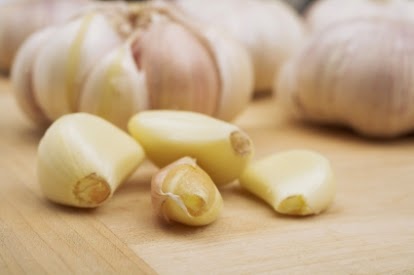Daun Kunyit = Turmeric Leaf
http://indonesiaoriginalrecipes.blogspot.com/
Turmeric (Curcuma longa) /ˈtɜrmərɪk/ or /ˈtjuːmərɪk/ or /ˈtuːmərɪk/[2] is a rhizomatous herbaceous perennial plant of the ginger family, Zingiberaceae.[3] It is native in southwest India, and needs temperatures between 20 and 30 °C (68 and 86 °F) and a considerable amount of annual rainfall to thrive.[4] Plants are gathered annually for their rhizomes, and propagated from some of those rhizomes in the following season.
When not used fresh, the rhizomes are boiled for about 30–45 minutes and then dried in hot ovens,[5] after which they are ground into a deep-orange-yellow powder commonly used as a spice in Indian cuisine and curries, for dyeing, and to impart color to mustard condiments. One active ingredient is curcumin, which has a distinctly earthy, slightly bitter, slightly hot peppery flavor and a mustardy smell.
Botanical view of Curcuma longa
Turmeric field in an Indian village
India, a significant producer of turmeric,[6] has regional names based on language and country.
Turmeric is a perennial herbaceous plant, which reaches up to 1 m tall. Highly branched, yellow to orange, cylindrical, aromatic rhizomes are found. The leaves are alternate and arranged in two rows . They are divided into leaf sheath, petiole, and leaf blade.[10] From the leaf sheaths, a false stem is formed. The petiole is 50 to 115 cm long. The simple leaf blades are usually 76 to 115 cm long and rarely up to 230 cm. They have a width of 38 to 45 cm and are oblong to elliptic narrowing at the tip .
Turmeric, whose biological name Curcuma longa, has been used in India as part of Ayurvedic medicine, and in Chinese medicine for thousands of years, to treat a variety of health conditions. An active ingredient in the turmeric leaf is curcumin, which is a powerful antioxidant.
As part of Ayurvedic medicine, turmeric leaves can be crushed into a paste and applied to the skin. This use dates back to ancient times and is still in use today in India. It is believed turmeric may help keep the skin soft and smooth, make the skin glow, produce a fairer complexion and remove blemishes such as spots. It is also used to alleviate skin conditions such as eczema and as an antiseptic to treat cuts and burns.
Tumeric leaves, also known as haldi leaves, are used extensively as aromatic herbs in Indian, Thai and Malaysian cooking. Fresh turmeric leaves are used whole in select dishes and dried turmeric leaves soaked in water with the extract used in cooking. Turmeric leaves are also used as food coloring and as a basic ingredient in curry powders. Turmeric leaves are purported to improve digestion and reduce gas and bloating.
Turmeric grows wild in the forests of South and Southeast Asia. It is one of the key ingredients in many Asian dishes. Indian traditional medicine, called Siddha, has recommended turmeric for medicine. Its use as a coloring agent is not of primary value in South Asian cuisine.
Turmeric is mostly used in savory dishes, but is used in some sweet dishes, such as the cake sfouf. In India, turmeric plant leaf is used to prepare special sweet dishes, patoleo, by layering rice flour and coconut-jaggery mixture on the leaf, and then closing and steaming it in a special copper steamer (goa).
In recipes outside South Asia, turmeric is sometimes used as an agent to impart a rich, custard-like yellow color. It is used in canned beverages, baked products, dairy products, ice cream, yogurt, yellow cakes, orange juice, biscuits, popcorn color, cereals, sauces, gelatins, etc. It is a significant ingredient in most commercial curry powders.
Most turmeric is used in the form of rhizome powder; in some regions (especially in Maharashtra, Goa, Konkan and Kanara), turmeric leaves are used to wrap and cook food. Turmeric leaves are mainly used in this way in areas where turmeric is grown locally, since the leaves used are freshly picked. Turmeric leaves impart a distinctive flavor.
Although typically used in its dried, powdered form, turmeric is also used fresh, like ginger. It has numerous uses in Far Eastern recipes, such as pickle that contains large chunks of soft turmeric, made from fresh turmeric.
Turmeric is widely used as a spice in South Asian and Middle Eastern cooking. Many Persian dishes use turmeric as a starter ingredient. Almost all Iranian khoresh dishes are started using onions caramelized in oil and turmeric, followed by other ingredients.
In India and Nepal, turmeric is widely grown and extensively used in many vegetable and meat dishes for its color, and is also used for its supposed value in traditional medicine.
In South Africa, turmeric is used to give boiled white rice a golden colour.
In Vietnamese cuisine, turmeric powder is used to color and enhance the flavors of certain dishes, such as bánh xèo, bánh khọt, and mi quang. The powder is also used in many other Vietnamese stir-fried and soup dishes.
In Indonesia, turmeric leaves are used for Minangese or Padangese curry base of Sumatra, such as rendang, sate padang, and many other varieties.
In Thailand, fresh turmeric rhizomes are widely used in many dishes, in particular in the southern Thai cuisine, such as the yellow curry (แกงเหลือง) and turmeric soup (ต้มขมิ้น).
In medieval Europe, turmeric became known as Indian saffron because it was widely used as an alternative to the far more expensive saffron spice.[14]
Source
WIKIPEDIA




































+indonesian+recipes.jpg)

